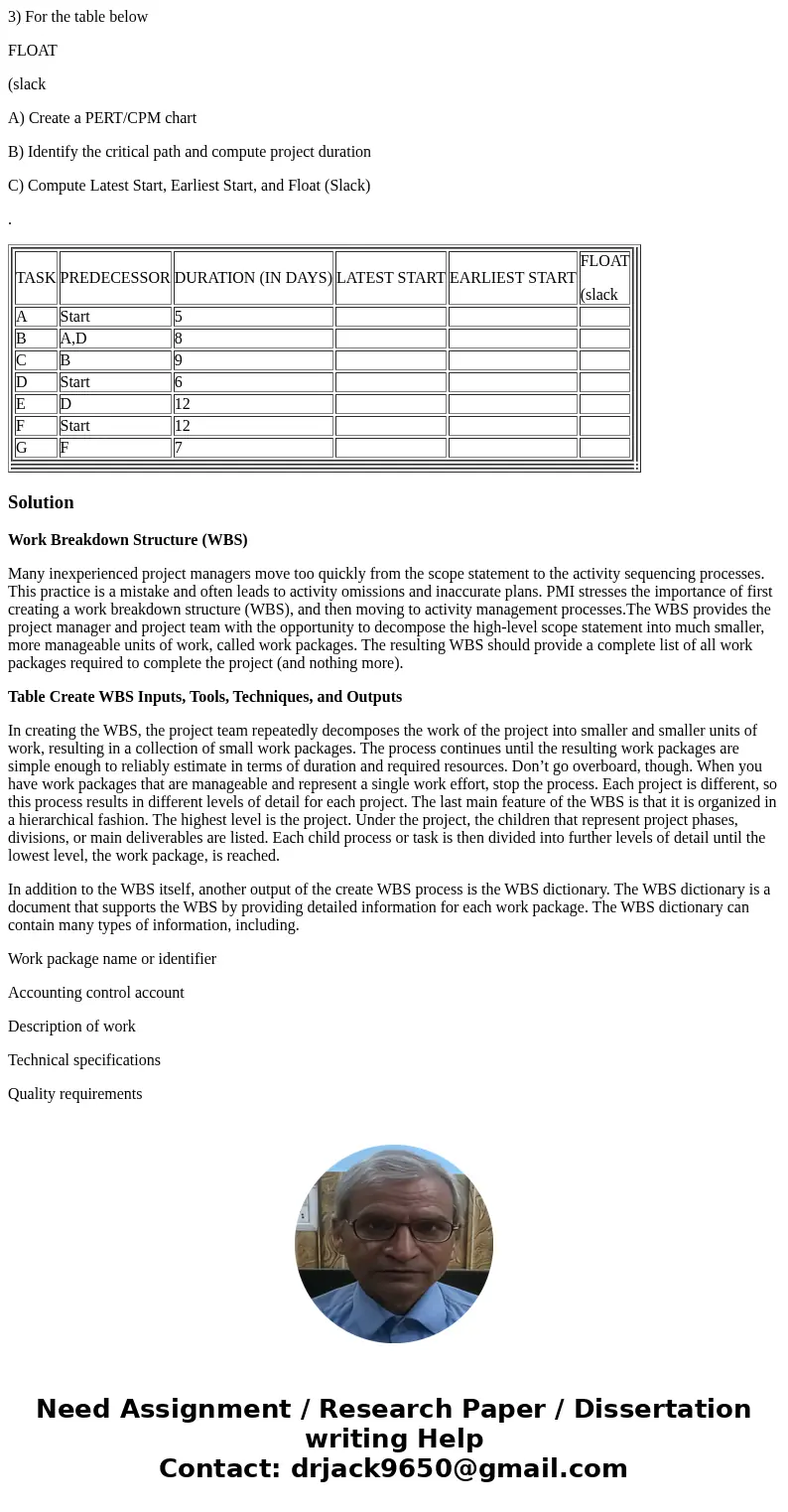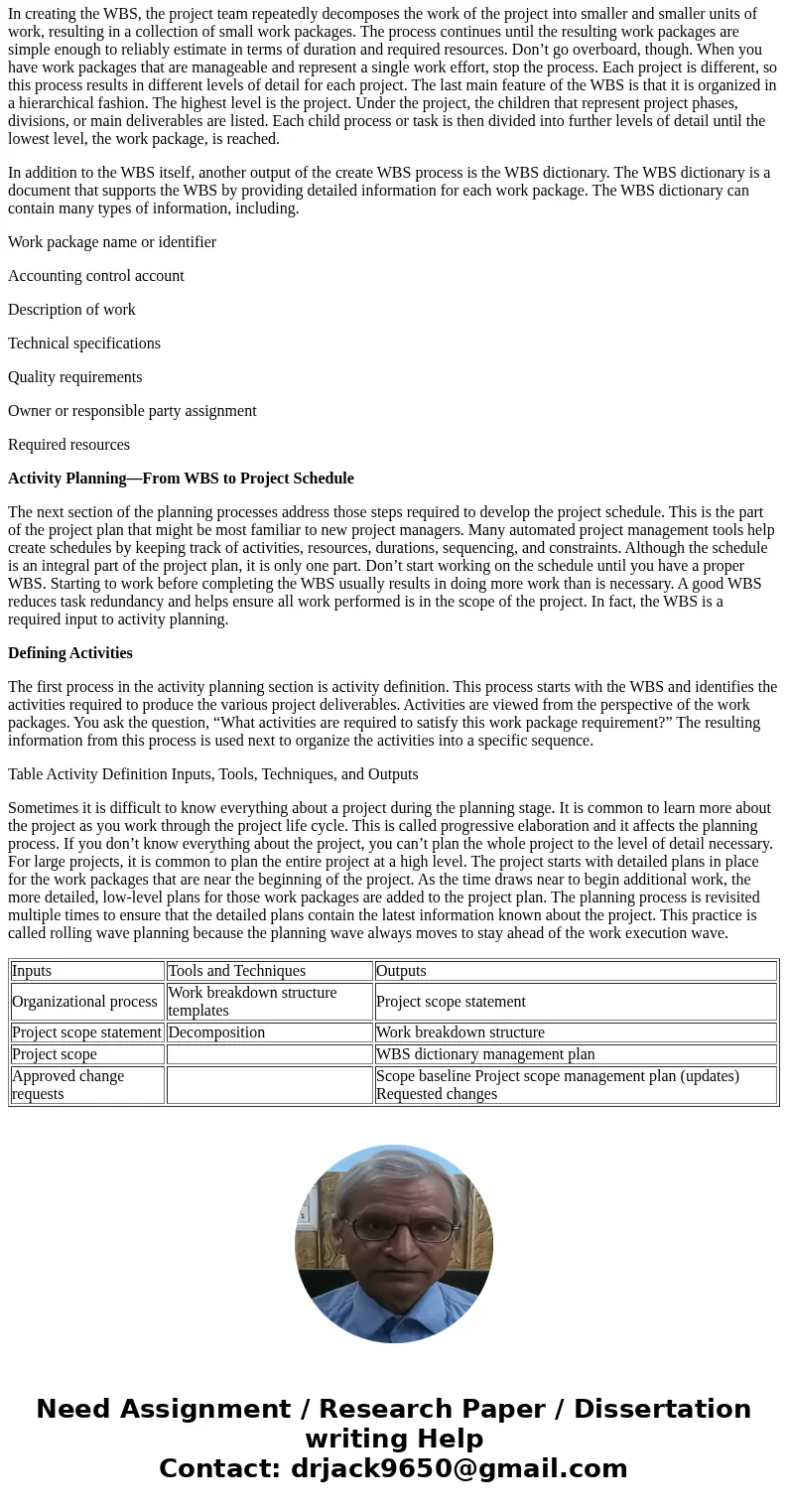3 For the table below FLOAT slack A Create a PERTCPM chart B
3) For the table below
FLOAT
(slack
A) Create a PERT/CPM chart
B) Identify the critical path and compute project duration
C) Compute Latest Start, Earliest Start, and Float (Slack)
.
| |||||||||||||||||||||||||||||||||||||||||||||||||
Solution
Work Breakdown Structure (WBS)
Many inexperienced project managers move too quickly from the scope statement to the activity sequencing processes. This practice is a mistake and often leads to activity omissions and inaccurate plans. PMI stresses the importance of first creating a work breakdown structure (WBS), and then moving to activity management processes.The WBS provides the project manager and project team with the opportunity to decompose the high-level scope statement into much smaller, more manageable units of work, called work packages. The resulting WBS should provide a complete list of all work packages required to complete the project (and nothing more).
Table Create WBS Inputs, Tools, Techniques, and Outputs
In creating the WBS, the project team repeatedly decomposes the work of the project into smaller and smaller units of work, resulting in a collection of small work packages. The process continues until the resulting work packages are simple enough to reliably estimate in terms of duration and required resources. Don’t go overboard, though. When you have work packages that are manageable and represent a single work effort, stop the process. Each project is different, so this process results in different levels of detail for each project. The last main feature of the WBS is that it is organized in a hierarchical fashion. The highest level is the project. Under the project, the children that represent project phases, divisions, or main deliverables are listed. Each child process or task is then divided into further levels of detail until the lowest level, the work package, is reached.
In addition to the WBS itself, another output of the create WBS process is the WBS dictionary. The WBS dictionary is a document that supports the WBS by providing detailed information for each work package. The WBS dictionary can contain many types of information, including.
Work package name or identifier
Accounting control account
Description of work
Technical specifications
Quality requirements
Owner or responsible party assignment
Required resources
Activity Planning—From WBS to Project Schedule
The next section of the planning processes address those steps required to develop the project schedule. This is the part of the project plan that might be most familiar to new project managers. Many automated project management tools help create schedules by keeping track of activities, resources, durations, sequencing, and constraints. Although the schedule is an integral part of the project plan, it is only one part. Don’t start working on the schedule until you have a proper WBS. Starting to work before completing the WBS usually results in doing more work than is necessary. A good WBS reduces task redundancy and helps ensure all work performed is in the scope of the project. In fact, the WBS is a required input to activity planning.
Defining Activities
The first process in the activity planning section is activity definition. This process starts with the WBS and identifies the activities required to produce the various project deliverables. Activities are viewed from the perspective of the work packages. You ask the question, “What activities are required to satisfy this work package requirement?” The resulting information from this process is used next to organize the activities into a specific sequence.
Table Activity Definition Inputs, Tools, Techniques, and Outputs
Sometimes it is difficult to know everything about a project during the planning stage. It is common to learn more about the project as you work through the project life cycle. This is called progressive elaboration and it affects the planning process. If you don’t know everything about the project, you can’t plan the whole project to the level of detail necessary. For large projects, it is common to plan the entire project at a high level. The project starts with detailed plans in place for the work packages that are near the beginning of the project. As the time draws near to begin additional work, the more detailed, low-level plans for those work packages are added to the project plan. The planning process is revisited multiple times to ensure that the detailed plans contain the latest information known about the project. This practice is called rolling wave planning because the planning wave always moves to stay ahead of the work execution wave.
| Inputs | Tools and Techniques | Outputs |
| Organizational process | Work breakdown structure templates | Project scope statement |
| Project scope statement | Decomposition | Work breakdown structure |
| Project scope | WBS dictionary management plan | |
| Approved change requests | Scope baseline Project scope management plan (updates) Requested changes |


 Homework Sourse
Homework Sourse